Casio Exilim EX-ZR10 Review
Casio Exilim EX-ZR10
This quick shooting, easy to use 12.1MP pocket camera packs in slow mo' movies, 360 degree panoramas, 7x optical zoom, HD capture and High Dynamic Range modes.
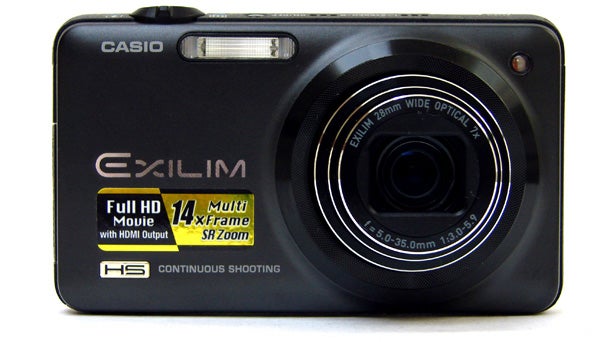
Verdict
Key Specifications
- Review Price: £249.00
“More features than you’d expect to find on a pocket camera”. That’s the pitch for the subject of today’s review, the Casio Exilim EX-ZR10 point and shoot. At first inspection it might well have the specs to support this claim, with a 7x optical zoom, Slide Panorama feature, 1080p video recording with HDMI output, and a high-speed video function supporting speeds up to 480 frames per second.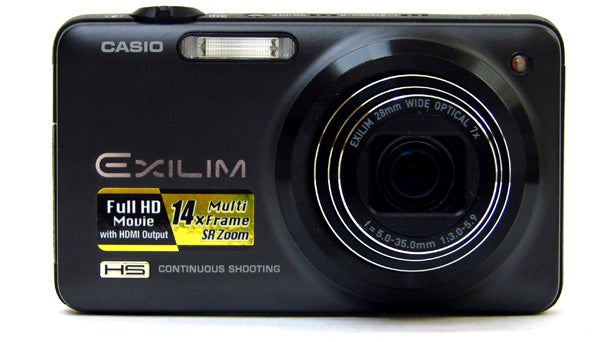
The EX-ZR10, not to be confused with the Pentax Optio RZ10, closely resembles Sony’s rival Cyber-shot WX5 in terms of its boxy yet not unsophisticated design. Even the control layout – via its top-mounted stereo microphones in particular – and feature set is similar, the Sony being some £20 cheaper at time of writing.
At 102 x 69 x 27mm the EX-ZR10 is not much bulkier than the average mobile phone and slips comfortably into any trouser pocket. While many rivals in this class have a 3x zoom, and the Sony WX5 a 5x zoom, Casio calls this model a ‘travel zoom’ and features a handy 7x optical zoom. This yields a versatile focal range stretching from a wide-angle 28mm to 196mm at the telephoto end (35mm equivalents), providing scope for shooting landscapes and candid close ups at a nudge of the zoom lever.
For getting even closer to the action there is the option of boosting to 14x zoom through a fancy equivalent of digital zoom that Casio calls Multi Frame SR zoom. Rather than just mere upscaling the image, sacrificing detail and sharpness, this function combines a number of images to try and achieve a clear shot. For general shooting, the f/3.0-f/5.9 lens is not particularly ‘fast’ but is at least average for its class. 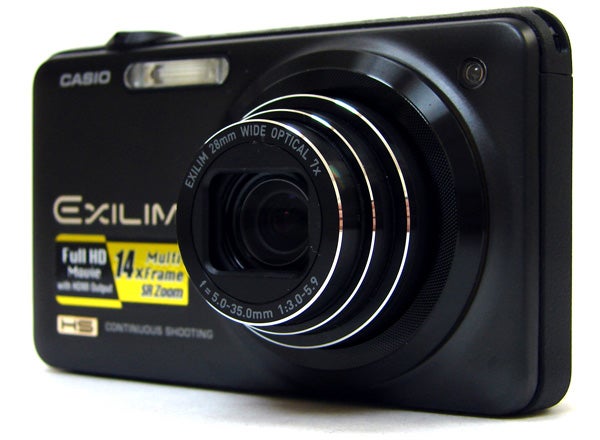
Having said all that, rather than push it as a high-zoom model, Casio is positioning the EX-ZR10 has a high-speed compact. It has shoehorned in dual image processors as well as a new ‘HS’ engine to, it claims, ramp up operational speed and reduce shot-to-shot times. For stills this translates as being able to capture 10 photos per second at the full 12.1 megapixels resolution while dropping fractionally to 10 megapixels will get you up to 40 frames per second.
While Sony’s latest models have the much trumpeted auto-stitching Sweep Panorama feature, the EX-ZR10 counters with its own impressive Slide Panorama for those who want to fully take in their surroundings. While the Casio doesn’t offer a stereoscopic version, it does allow the photographer to pan with the camera through a full 360° arc. Do so, and you’ll hear a machine gun-like sample of a shutter rapidly firing, the Casio automatically delivering a single elongated image at the end of the process, without the need to resort to specialist stitching software. It’s a fun tool with great creative potential.
Shooting video also boasts some impressive performance, with Full HD 1080p at 30fps. Select High Speed mode and you can record at up to 480 frames per second, albeit at the dramatically reduced resolution of 224 x 160 pixels. Great for grabbing headlines but the sub-webcam resolution means this super slow-motion mode is less useful than we’d hoped.
At least the same criticism can’t be said of the other aspects of video reporting with this camera. A dedicated record button is a welcome addition, as the the ability to use the zoom fully while filming – something a layman would assume every camera could do yet frustratingly absent from some models we’ve tested. There is also an HDMI output for playing back your videos directly to your TV.
It does however indeed appear that Casio has lived up to its stated intention and packed a fair amount in to this pocket camera, with more to come as we’ll see.
The Casio Exilim EX-ZR10 weighs a solid yet not too intrusive 176g including rechargeable lithium ion battery and an SD, SDHC or SDXC media card inserted. Build quality is high, with a greater proportion of metal in the chassis than plastic. We admired its magnesium alloy-a-like strip across the top plate, which drops down at either side, and we actually prefer its overall more rugged feel to its smaller, sexier Sony WX5 rival.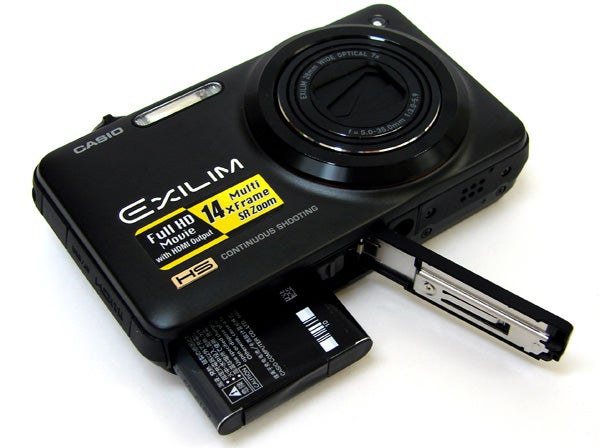
Perhaps inevitably, given the high demand for cameras majoring equally in style and substance, the EX-ZR10 doesn’t feature anything that could be advertised as a handgrip. The slightly raised and rough textured Exilm logo at the front is the only thing that stops fingers from sliding around the smooth faceplate, though this is probably accidental, while there’s no pad or indentation for the thumb at the rear either. Instead your digit falls slightly awkwardly on the one-touch button for recording video. Instinctively then, you raise your left hand to grip the other side of the camera, the thumb inevitably finding its way onto the otherwise clear 3-inch, 460,800-dot resolution LCD screen (960 x 480 pixels), which, in fact, hides any smears better than most.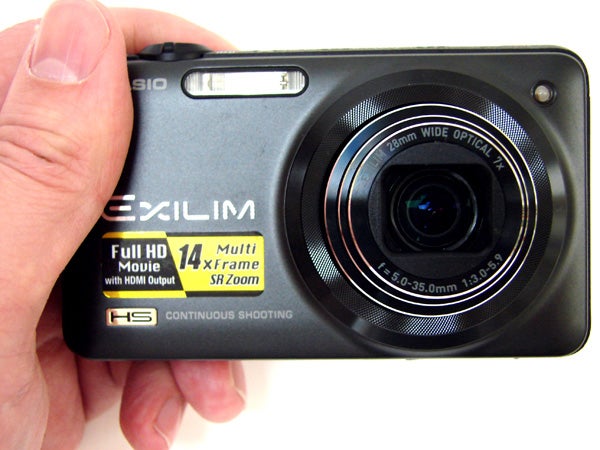
Like the rest of the Casio range, the EX-ZR10 features a select of subject and scene specific BestShot modes. Here we’re provided with 17 in total, but whereas other models feature a dedicated BestShot mode button, it is not immediately obvious how to locate them on the ZR10. In fact a press of the ‘HS’ (High Speed’) button on the top plate displays the available choices, so some exploratory prods are required when you first pick up the camera. Apart from the aforementioned Slide Panorama option, the other BestShot modes are in the main heavily biased towards action photography, even if that does boil down to photographing the kids’ tennis matches or the family dog leaping about.
Slightly more excitingly for those who want to get creative, the Casio features two high dynamic range options: a regular (and rather subtly done) HDR mode which to all intents and purposes resembles a realistically even exposure, plus the even more visually dynamic HDR Art. The latter throws subtlety out of the window, combining a rapid burst of frames (so avoiding any hand wobble/image blur) to provide a more obviously processed image that gives the everyday an ‘acid trip’-like treatment with heightened colour and contrast. That said, it can give a drab subject much more impact, if you don’t mind a result more akin to a visual effect than a photograph. 
With this feature again fully automatic once you’ve made your selection, this isn’t really the camera for those who want manual control. Aside from the ‘BestShot’ selections, there is only the ability to adjust the likes of light sensitivity – ISO 100 through ISO 3200 – white balance, exposure compensation ( /- 2EV), flash settings and that’s basically it. Look to the Casio Exilim EX-H20G if you want marginally more control. Like that model, key shooting options are presented in a toolbar that runs down the right hand side of the camera’s screen, each setting highlighted as the user tabs up or down, via the usual intuitive four way control pad.
Press the match-head sized on/off button on the Exilim EX-ZR10’s top plate and the zoom lens bursts out from the body in an instant, rear LCD screen taking a moment to catch up. This meant that we were able to be up and shooting with the Casio in just under two seconds, which isn’t bad at all for a snapshot model.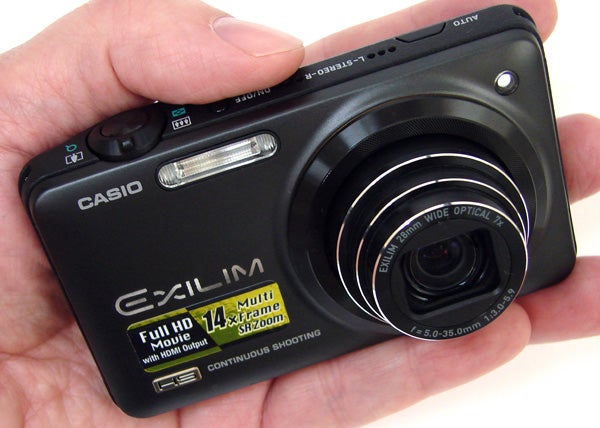
On this camera, as well as the aforementioned BestShot modes, there are two Auto modes. The regular Auto mode is essentially an ‘intelligent auto’ option that recognises common scenes and subjects and adjusts camera settings automatically. Alternatively there is the same image-enhancing Premium Auto that we also found on the EX-H20G. This slows down processing times marginally, which is not an issue, although most of the time we were hard pressed to tell the difference.
Rather than bury these under menus with the other ‘BestShot’ modes, there is a dedicated ‘Auto’ button on the top of the camera which switches from one auto mode to the other so you can shoot the same subject with both options and decide for yourself which looks best. This really is a camera for those who want a decent-looking result with very little input of their own.
In terms of stills quality, the usual bugbears of any digital compact make an appearance – namely pixel fringing between areas of high contrast, but more disappointingly a distinct softness towards the corners of frame when shooting at maximum wideangle, rather than any noticeable barrel distortion. This is one of the few black marks against the EX-ZR10, but unfortunately a fairly prominent one. 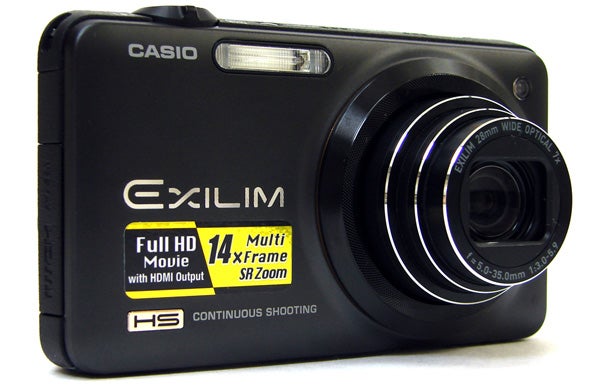
On a more positive note we were impressed with the level of pin-sharp detail across the frame we were able to achieve when shooing handheld at maximum telephoto setting. This is testament not only to the lens itself, but also the camera’s built in image stabilisation mechanism – here of the fairly reliable and consistent CMOS sensor shift variety.
This being a Casio camera colours are well saturated as a default, and if you do want a dynamic boost on a dull and flat day, then both standard HDR and HDR Art modes can supply it within a couple of button presses.
For low light photography we managed to get a decent return on images even when shooting up to the top whack sensitivity setting of ISO 3200. As you’d expect, noise starts to subtly intrude from ISO 400 upwards, detail softening slightly at ISO 800 and getting subtly more so at ISO 1600. Though at ISO 3200 detail is at its least sharp, we’d argue that results at this setting are certainly as good as most compacts manage at ISO 1600, so can be utilised if push comes to shove. Certainly the ZR10 largely avoids the painterly look that most images from point and shoots take on at ISO3200 (including Casio’s own EX-H20G). See our test images on the following pages for a first-hand view.
Verdict
For those who just want to point and shoot in the main, but would occasionally appreciate a couple of extra gizmos at their fingertips for when they start to get bored, the EX-ZR10 comes into its own. The HDR features, Slide Panorama, slow-motion video clips and general speediness of operation impress. Sadly this is let down by corner softness at the maximum wide angle – one of the most often-used focal lengths for a compact camera. In this respect the Sony Cyber-shot WX5 may be a better bet for anyone looking for similar features and portability, yet sharper overall shots at extreme wide angle setting. Watch out for our full review next week.
Otherwise images are detailed, response time (mostly) lightning quick and overall build quality is good. ‘Could do far worse’ seems like feint praise, but when levelled at the Exilim EX-ZR10 it is also particularly fitting.
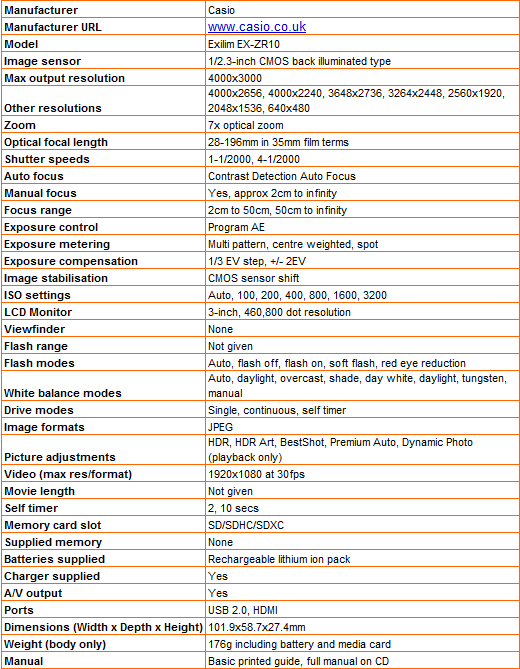
”’A selection of images taken at the camera’s incremental light sensitivity settings, using only available daylight, against a white background and with white balance set to auto.””
—-
—-

Shooting with the EX-ZR10 set to Auto ISO, it has chosen a setting equivalent to ISO 160. A good choice as this has produced a crisp and clear, noise free result.
—-

Same composition shot at ISO 100, the lowest manually selectable setting, and as you’d expect a barely discernible difference in appearance.
—-

Same lack of noise to report at ISO 200, so the camera is performing as well as we would expect for its point and shoot class.
—-

We’re at ISO 400, usually the setting at which noise begins to creep in on if we’re unlucky. Here, if we’re being particularly picky, some very fine grain is creeping into shadow detail, but most wouldn’t notice.
—-

Marginally more obvious noise and softening of edge detail at ISO 800, but still a more than acceptable performance from the Casio.
—-

Softer again and more obvious noise at ISO 1600. But, as we noted in our review of the EX-H20G, we’d still be happy reaching for this option when pushed.
—-

At ISO3200, even without the need to crop in on detail it’s obvious that we’re losing it, with a softened look across the entire image. Again though it’s an option to reach for when pushed, and especially if you might not otherwise achieve the image you hope for.
—-
”’A more general selection of unadjusted test shots are revealed on this page and next to act as an evaluation of the Casio Exilim EX-ZR10 in a variety of shooting conditions.”’
—-

A maximum 28mm equivalent wideangle shot taken with the Casio, any possible instance of barrel distortion well disguised by the natural setting. However we’re noticing some quite alarming loss of definition towards the corners of the frame, most noticeably in the blurred branches of the trees top left and right.
—-

And for comparison an image taken from the same spot at maximum 196mm equivalent telephoto setting. By contrast this image is fairly sharp all over. Nice natural colours from the Casio too.
—-

Here we’ve zoomed in further courtesy of the Casio’s extended zoom option, which runs on, if left unchecked, once the 7x optical option has been exhausted. We’d argue the distinctly soft and digital looking result is no better than the result from your average digital zoom, and in our opinion best avoided.
—-
![]()
And here’s an idea of the results achievable using the fun Casio’s Slide Panorama BestShot mode, which promises the ability to shoot full 360°s. If you look at each edge of the frame you’ll see it’s possible to get the same subject appearing twice if you’re not too careful.
—-
”’Intro copy”’
Here are some general test shots taken with the EX-ZR10 to give an idea of performance ability when it comes to image quality, dynamic range, colour rendition and performance at differing focal ranges.
—-

Lovers of warmly saturated colours will enjoy experimenting with the Casio’s HDR Art setting – although the results here in this extreme close up cannot be described as in any way natural. In fact they are distinctly psychedelic in flavour. Choose the regular HDR option if it’s subtler, more even exposures you’re after.
—-

By contrast an image taken at maximum telephoto setting and using the regular auto more for more naturalistic results. As we’ve noted in the past, Casio’s default colour tones err towards the flatteringly warm anyway.
—-

Some lovely blue-tinged daylight colours here befitting of a crisp and clear winter’s day, although both display tell tale pixel fringing where the tree branches meet sky and metal poles do the same. Both display a good level of sharp detail throughout most of the frame, but again focus is falling away toward the corners.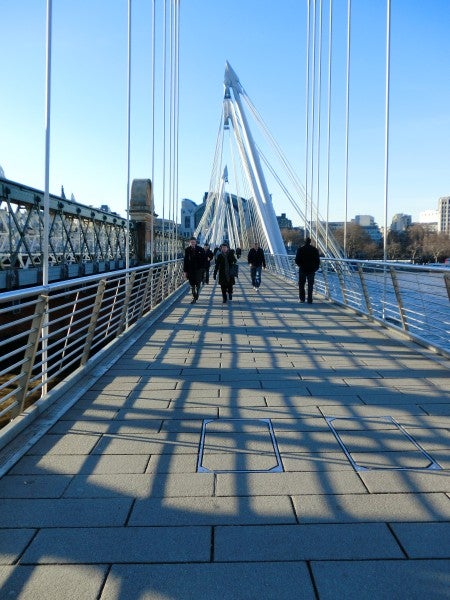
—-
Trusted Score
Score in detail
-
Value 7
-
Image Quality 8
Features
| Camera type | Digital Compact |
| Megapixels (Megapixel) | 12.1 Megapixel |
| Optical Zoom (Times) | 7x |
| Image Sensor | 1/2.3-inch CMOS back illuminated type |
| Optical focal length | 28-196mm in 35mm film terms |
| Shutter speed | 1-1/2000, 4-1/2000 |
| Auto focus | Contrast Detection Auto Focus |
| Manual focus | Yes, approx 2cm to infinity |
| Max output resolution | 4000x3000 |
| Other resolutions | 4000x2656,4000x2240,3648x2736,3264x2448,2560x1920,2048x1536,640x480 |
| Focus range | 2cm to 50cm, 50cm to infinity |
| Exposure control | Program AE |
| Exposure metering | Multi pattern, centre weighted, spot |
| Exposure compensation | 1/3 EV step, +/- 2EV |
| Image Stabilisation | CMOS sensor shift |
| ISO settings | Auto, 100, 200, 400, 800, 1600, 3200 |
| LCD Monitor | 3-inch, 460,800 dot resolution |
| Viewfinder | None |
| Flash range | Not given |
| Flash modes | Auto, flash off, flash on, soft flash, red eye reduction |
| White balance modes | Auto, daylight, overcast, shade, day white, daylight, tungsten, manual |
| Drive modes | Single, continuous, self timer |
| Image formats | JPEG |
| Picture adjustments | HDR, HDR Art, BestShot, Premium Auto, Dynamic Photo (playback only) |
| Video (max res/format) | 1920x1080 at 30fps |
| Movie length | Not given |
| Self timer | 2, 10 secs |
| Memory card slot | SD/SDHC/SDXC |
| Supplied memory | None |
| Batteries supplied | Rechargeable lithium ion pack |
| Charger supplied | Yes |
| A/V output | Yes |
| Charging/Computer Connection | USB 2.0 |
| HDMI | Yes |
| AV Out | Yes |
| Manual | Basic printed guide, full manual on CD |
Physical Specifications
| Dimensions Width (Millimeter) | 101.9mm |
| Depth (Millimeter) | 58.7mm |
| Weight (body only) (Kilogram) | 176g including battery and media cardkg |

